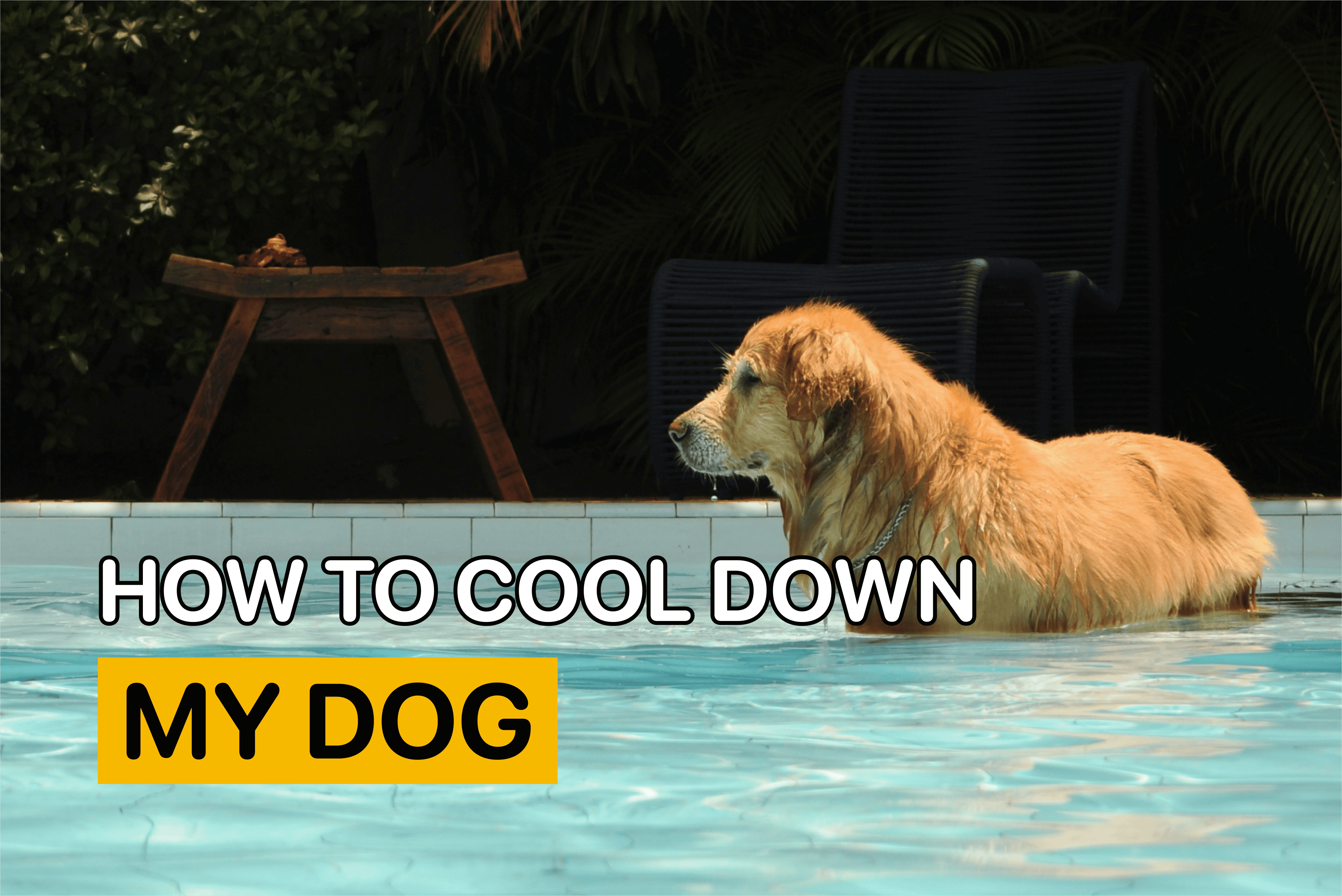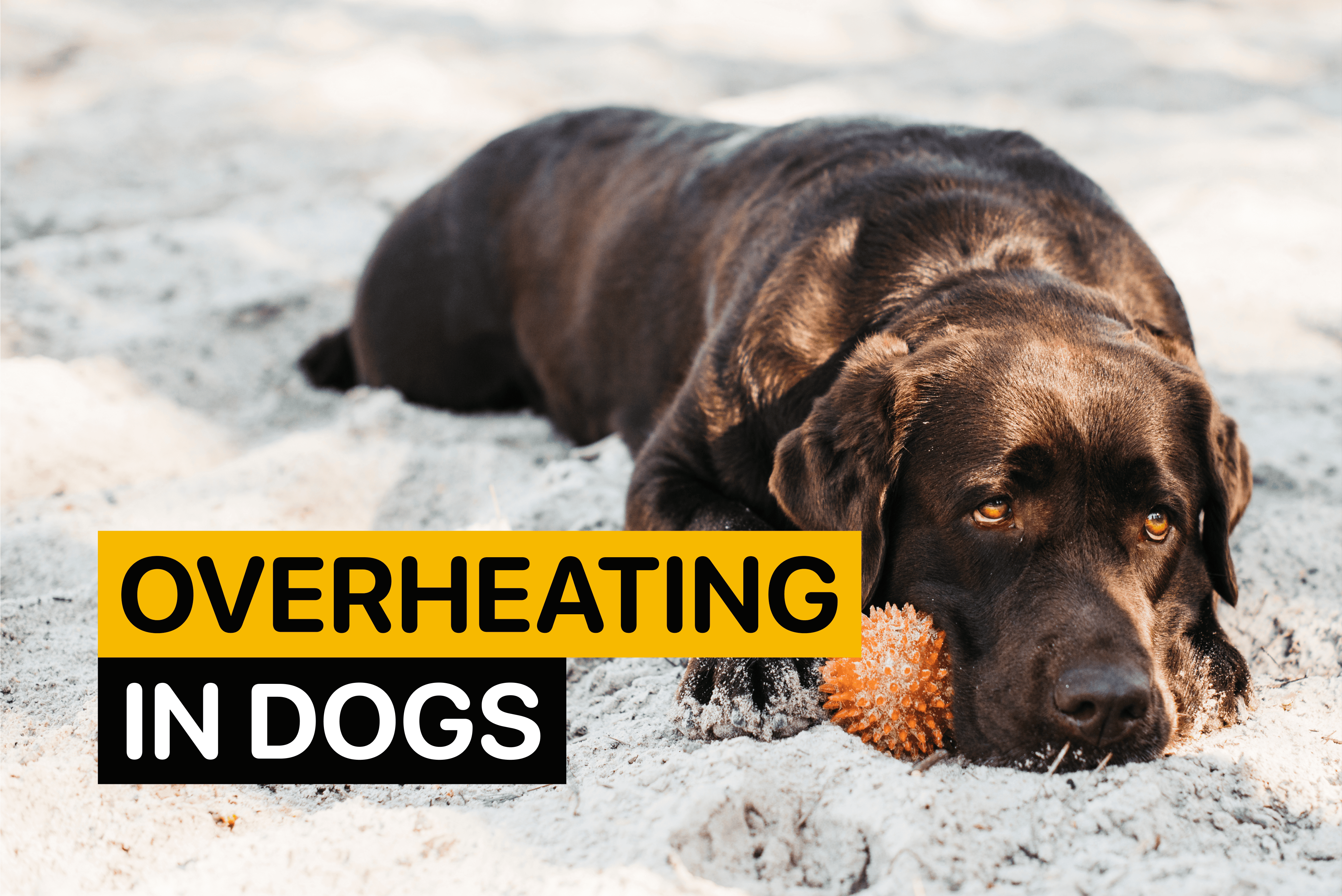How to Keep Dogs Cool in Hot Weather: Dog Care Tips

By
Woofz Team Updated on |Reviewed by
Karen PiwinskiExtreme heat poses a danger to dogs and humans alike. Canines, however, are even more likely than we are to develop health issues as a result of exposure to hot weather. As their body temperature regulation is less effective, even moderate exercise or a short walk in scorching weather can lead to heat stroke, a potentially fatal condition.
Considering these risks, keeping dogs cool in hot weather is crucial for their well-being. Let’s get into an in-depth review of practical ways to keep dogs cool in summer.
How to Keep Dogs Cool in Summer: 9 Practical Considerations
Keeping your dog cool in summer can be challenging, especially in record-breaking heat. However, pet owners should be mindful of the dangers a hot day can bring and take the necessary precautions to prevent their furry companions from overheating. Simple lifestyle modifications can ensure your pooch’s safety when the temperature goes up.
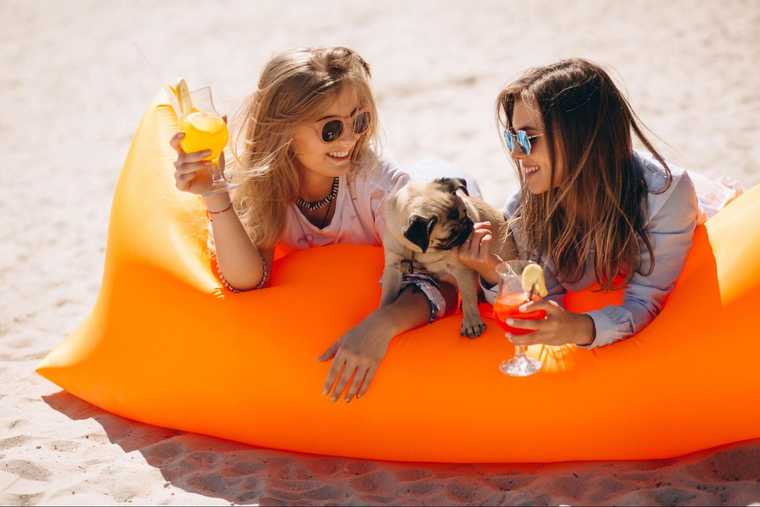
Let’s review some of the preventive measures effective for keeping pets safe during heat waves.
1. Stay away from the midday heat
Walking your furry family member is essential for their physical and mental stimulation. But spending time outdoors in hot weather can bring more risks than benefits. Apart from the risk of overheating, midday walks can be dangerous for several reasons.
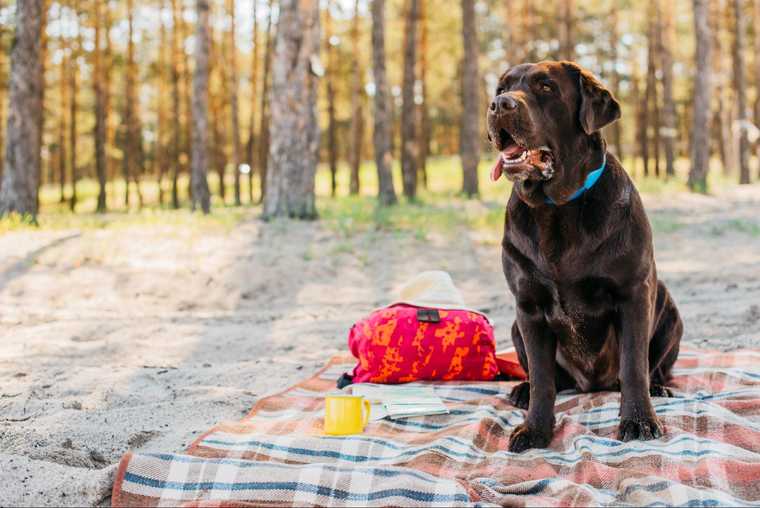
Avoid walking a dog in the afternoon because:
- The air temperature can get to the point where heat stroke is possible (anything above 80°F (26°C) is too dangerous for most breeds).
- Hot sidewalk can cause burns on your dog’s sensitive paw pads.
- Insects, such as bees and wasps, and snakes are more active during the day, so the risk of wildlife-related injuries increases.
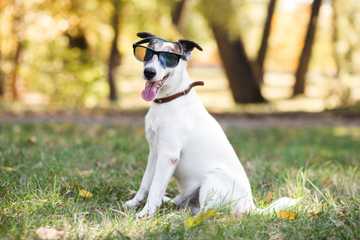
A dog, however, can’t stay locked indoors for several hot weeks or even months in summer. So, any responsible pet parents should aim to strike a balance between the advantages and dangers summer walks can pose. Fortunately, there are ways you can minimize the risks associated with summer heat.
How to keep dogs cool in hot weather:
-
Adjust walking time and spend time outside early in the morning or late in the evening, when the air temperature drops. Also, check the humidity – 80°F at 40% humidity is much more comfortable than at 90% humidity.
-
Always check the sidewalk temperature (use your palm to determine whether it’s too hot) and make your pooch wear paw protection (special booties) if the asphalt is overheated.
-
Bring fresh water with you on the walks to keep your pet hydrated, especially if you exercise outdoors.
-
Walk in areas with plenty of shade and grass to reduce the risks of overheating and burns.
-
Make the walks shorter and consider stopping exercises altogether when the weather is too hot.
2. Apply dog-friendly sun cream regularly
Because canines are covered with fur, you may think they don’t get sunburn.
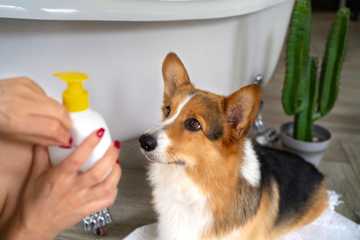
What pet parents may overlook is that body parts such as a dog’s ears, nose, or belly are exposed to the sunlight. That’s why it’s essential to apply a proper dog-friendly sunscreen to protect the skin from the dangers of UV light.
To apply sun cream properly:
- Use only dog-friendly products, as sunscreen developed for humans can be toxic for pets.
- Apply sunscreen to vulnerable areas such as the nose (especially lighter or white patches), ears, belly, and any spots with thin or no fur.
- Avoid the area around the eyes to prevent eye irritation.
- Reapply sunscreen regularly as the product label suggests or after swimming.
- Let the sunscreen product absorb properly before taking your dog outside or in the water (distract them from licking the cream after applying it).
3. Never leave your dog unattended in a parked car
Many owners underestimate the dangers of leaving their furry friend unattended in a car in summer.
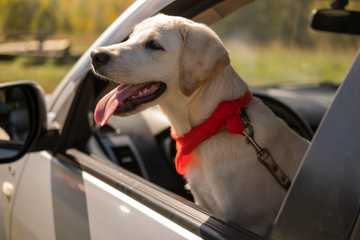
Cars get dangerously hot, even when the temperature outdoors seems tolerable. For example, a vehicle parked at 80°F (26°C) can reach an alarming 109°F (42°C) in only 20 minutes. That’s why you should never leave your dog alone in a car in warm weather.
4. Avoid or minimize the time spent in a dog house
It’s best to let your dog inside during a hot day and keep them in well-ventilated areas, preferably equipped with air conditioning. The problem with dog houses is that they usually don’t have proper airflow, so they can get hot in summer weather. If you don’t have a choice but to keep your dog outside, ensure they stay in a shady spot and have unlimited access to cool water (adding ice cubes in the water bowl can help too). A cool water sprinkler system can also be a great way to help dogs stay refreshed while outdoors in the heat.
5. Get a fan to cool down your dog
Using a battery-operated fan helps keep dogs cool in summer, especially if combined with other cooling mechanisms. As canines use mostly panting, not sweating, to dissipate the heat, a fan’s airflow will be less adequate for dogs than for humans. However, in mild heat or paired with a cooling mat or even air conditioning, fans can become more efficient and provide your pooch with some relief.
When kenneling dogs outdoors, consider setting up multiple safe fans, such as box fans mounted on kennel doors, to improve airflow. There are also smaller fans designed specifically for crates or compact spaces. Just be sure to use fan models with safety features and keep any cords out of reach to prevent chewing.
Safety tips to consider when using a fan:
- Ensure your dog feels comfortable and doesn’t get stressed or anxious when the fan is on.
- Allow your dog to move away freely from direct airflow.
- Don’t place water close to electrical cords.
- Make sure all wires are securely out of reach from your dog to prevent chewing.
6. Interrupt the walks to cool down
You can make walking a dog in hot and humid weather less stressful by taking breaks from rigorous walking and allowing them to unwind in a cooler environment. Ideally, stop at a spot with enough airflow to cool down your pooch. Also, choose a shady spot to avoid direct sunlight and offer your companion some water to maintain proper hydration.
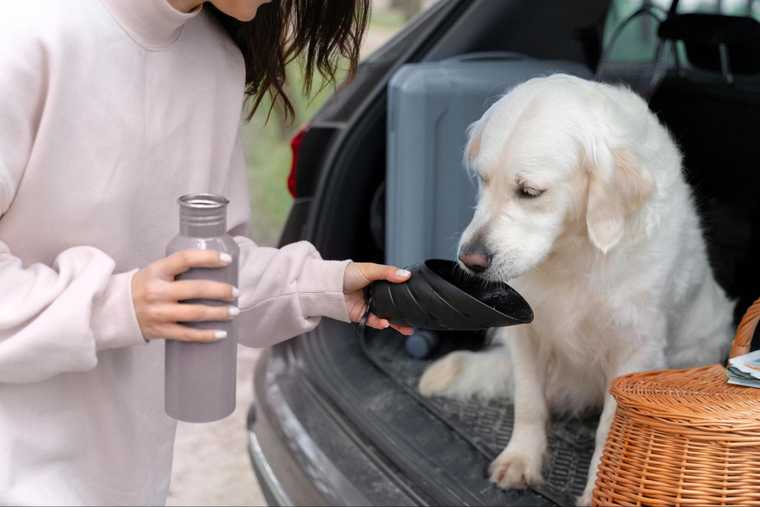
7. Exercise at cooler times of the day
When exercising a pooch on a hot day, it’s crucial to prioritize their safety. Since warm weather increases the risk of overheating, choose cooler periods for being physically active outdoors. Early mornings or late evenings are excellent for playing with your dog in summer.
You can also consider water-based activities, as they’re usually low-impact exercises and offer an excellent opportunity for dogs to cool down. For example, dock diving, swimming in pools, playing in sprinklers at home, or enjoying supervised swims in rivers and lakes. Be cautious of water quality – avoid areas with toxic algae blooms, such as blue-green algae (cyanobacteria), which can be harmful or even fatal to dogs if ingested.
Additionally, you can switch to more frequent indoor playtimes. Offer your furry companion the chance to play tug-of-war or fetch to provide them with sufficient physical and mental stimulation each day.
8. Don’t shave off your dog’s coat
It may seem logical to shave your dog’s fur to prevent trapping body heat.
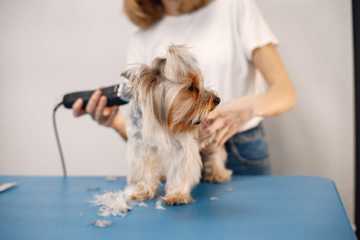
Body temperature regulation in canines doesn’t work this way. According to Dr. Jerry Klein, Chief Veterinary Officer for the AKC, shaving a canine’s fur removes the layer of insulation necessary to keep their skin protected from sunburn. It can also increase the risk of heat stroke and skin cancer.
You can opt for gentle brushing of the fur instead. It will allow you to remove the dead undercoat and improve airflow. Such steps help your pet effectively cool down without damage to their coat.
9. Avoid overfeeding in hot weather
Most dogs benefit from diet changes in boiling weather. You can use food as one of the mechanisms to cool down a dog and keep them hydrated. For instance, you can include more fruits and lean protein to help your pet better regulate their body temperature.

How to feed a dog in summer:
- Offer smaller and more frequent portions
- Schedule meals for early mornings and late evenings
- Ensure free access to cool water
- Offer wet dog food more often
- Monitor your dog’s appetite and change the size and frequency of meals accordingly.
How to Keep a Dog Cool Inside the House
Housing dogs should adhere to specific norms and regulations stated by the Animal and Plant Health Inspection Service of the US Department of Agriculture. According to their Animal Tech Care Note, the temperature inside the house where a dog lives shouldn’t be higher than 85°F (29.5 °C) for more than 4 hours in a row.

If the temperature inside exceeds these conditions, pet owners are obliged to provide additional cooling. They can use fans, blowers, and air conditioning to keep the air cool enough. However, dog parents can make the conditions inside their houses even more comfortable for a pooch by using more specific tools and strategies.
For example, encourage your dog to lie on cool tile, linoleum, or other hard flooring surfaces rather than carpet, as these can help them regulate their body temperature more effectively.
1. Use an elevated or cooling bed
One of the ways to help your pooch regulate their body temperature more effectively is to set up an elevated cooling bed for them. They lift your pet off a warm surface (e.g., a carpeted floor) and provide consistent air flow beneath to keep your dog cool. The circulation of air under the bed is beneficial for reducing body heat.

Some beds can also include more advanced cooling options, like breathable fabrics or cooling gels. They can also be more practical for older dogs with joint issues, as they reduce pressure on a dog’s knees and elbows. Finally, these beds are mobile and easy to move from one room to another, so you can change their location throughout the day to avoid the sunny and hotter side of the house.
2. Chill their water
We can’t emphasize enough the importance of cold water for a dog during the day. Panting, which is in essence breathing out hot air from the lungs, leads to emptying a canine’s water reserves. A dehydrated dog is much more prone to developing heat stress and heat exhaustion.
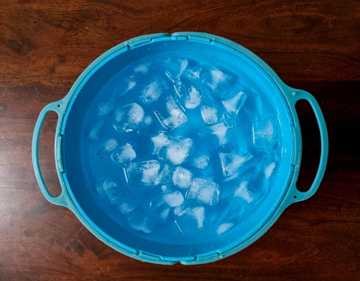
Whether you go for a relaxed walk in the park, play outdoors, or stay in the house where the air is hotter, ensure your dog has plenty of water they can access freely (bring a collapsible water bowl and water bottle with you). As a rule of thumb, double your pet’s water consumption in hot weather.
Cool water helps dogs cool down more effectively. While ice placed in a water bowl can help keep the water cooler for longer, it’s best to avoid giving dogs ice cubes directly – these can be hard on their teeth and may cause issues if they drink too quickly. Ideally, offer water that is room temperature or just slightly cool, as very cold water can sometimes be a shock to their system.
3. Give frozen treats and toys
Another excellent option for helping canines survive hot summer months is adding frozen treats to their diet. It’s best to steer away from products aimed at humans, such as ice cream. Instead, you can prepare DIY treats that won’t be harmful to your furry friend’s digestive system.

Consider offering these treats:
- Frozen green beans and fruits (banana, peaches, strawberries)
- Frozen mix of plain yoghurt with pumpkin or sweet potato
- Homemade ice cream from pureed pumpkin
- Frozen grilled chicken mixed with cooked carrots.
In addition, you can offer your dog frozen toys to play with during the summer days. You can either fill toys with water before freezing (like Kong Classic) or freeze them as they are. A more unusual, yet simple, solution is to freeze a damp towel and offer it for a dog to lie on or chew on.
However, it’s important to ensure that frozen treats or toys don’t make up more than about 10% of your dog’s overall diet, as excessive consumption can lead to an unbalanced diet and may cause digestive issues such as diarrhea.
4. Close blinds to block direct sunlight
Finally, a simple step like closing the blinds and blocking windows can help reduce air temperature and cool down the environment. Blocking the hot sun can decrease heat gain by as much as 45%. Reflective blinds can further enhance this effect.
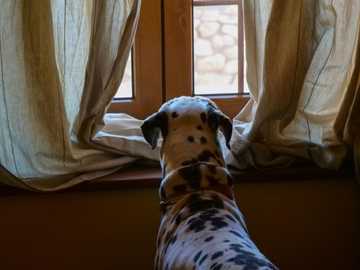
We suggest closing blinds during the hottest parts of the day to prevent the room from absorbing sun rays and getting hotter. But open them periodically to allow cooler air to come in when the temperature outside drops.
Wrap Up
To reduce the risk of heat stress and heat stroke in dogs, owners must pay extra attention to cooling down their companions during hot weather. Effective ways to do it are to change your dog’s walking time, provide enough cool water during the day, and modify your lifestyle in such a way that your pet’s exposure to extreme heat is limited. Keep in mind that you should also ensure proper conditions (such as air conditioning) for housing a canine at home. Following these simple rules reduces health risks for your dog and helps them sail through summer heat comfortably!
